12 MES3000 Ethernet switch series
When learning is disabled, the data coming to any port will be transmitted to all
other ports of the switch. In learning mode, the switch performs analysis of the
frame, discovers sender's MAC address and adds it to the routing table.
Afterwards, Ethernet frames dedicated to the host, which MAC address has been
already added to the routing table, will be sent only to the port specified in the
table.
This function allows to perform one-to-many or many-to-many data distribution.
Thus, the frame addressed to the multicast group will be transmitted to each port
of the group.
Automatic aging for
MAC addresses
If there are no packets from the device with the specific MAC address in the
definite period of time, the record for this address expires and will be removed. It
allows to keep the switch table up to date.
Network switch allows you to define static records of MAC address matches, that
will be saved to the routing table.
MAC address notification allows to monitor the availability of the network
equipment by saving MAC address learning history.
2.2.3 Second-layer functions of OSI model correspondence
Table 2.3 lists second-layer functions and aspects (OSI Layer 2).
Table 2.3 —Second-layer functions description (OSI Layer 2)
IGMP implementation analyzes the contents of IGMP packets and allows to
discover network devices participating in multicast groups and forward the traffic
to the corresponding ports.
MLD protocol implementation allows the device to minimize multicast IPv6 traffic.
Function that allows to redirect multicast traffic to another VLAN using IGMP
messages and to reduce the load to the uplink port. Used in III-play solutions.
Broadcast storm is a multiplication of broadcast messages in each host causing
their exponential growth, that can lead to a network meltdown. MES3000 devices
has a function that restricts the transfer rate for multicast and broadcast frames
received and sent by the switch.
Port mirroring allows to duplicate the traffic for monitored ports, sending ingress
and/or egress packets to the controlling port. Switch users can define controlled
and controlling ports and select the type of traffic (ingress or egress) that will be
sent to the controlling port.
This function allows to assign the uplink port to the switch port. This uplink port
will receive all the traffic and provide isolation from other ports (within a single
switch) located in the same broadcast domain (VLAN).
This function allows to isolate the group of ports (within a single switch) located in
the same broadcast domain from each other, allowing traffic exchange with other
ports located in the same broadcast domain, but not belonging to this group.
Provides isolation of devices located in the same broadcast domain within L2
network. Following port operation modes are implemented—Promiscuous,
Isolated (isolated ports cannot exchange traffic) and Community (ports can
exchange data with each other and Promiscuous port)

